|
|
|
Sort Order |
|
|
|
Items / Page
|
|
|
|
|
|
|
| Srl | Item |
| 1 |
ID:
077132
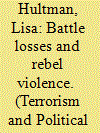

|
|
|
|
|
| Publication |
2007.
|
| Summary/Abstract |
In many armed conflicts, rebel groups deliberately target civilians. This article examines whether such violence is related to the performance of the rebels on the battlefield. It is proposed that rebel groups who are losing battles target civilians in order to impose extra costs on the government. When rebels attack civilians, the government may incur both political and military costs. Violence against civilians is thus used as an alternative conflict strategy aimed at pressuring the government into concessions. The argument is evaluated by using monthly data for rebel groups involved in armed conflict from January 2002 to December 2004.
|
|
|
|
|
|
|
|
|
|
|
|
|
|
|
|
| 2 |
ID:
135954


|
|
|
|
|
| Summary/Abstract |
While United Nations peacekeeping missions were created to keep peace and perform post-conflict activities, since the end of the Cold War peacekeepers are more often deployed to active conflicts. Yet, we know little about their ability to manage ongoing violence. This article provides the first broad empirical examination of UN peacekeeping effectiveness in reducing battlefield violence in civil wars. We analyze how the number of UN peacekeeping personnel deployed influences the amount of battlefield deaths in all civil wars in Africa from 1992 to 2011. The analyses show that increasing numbers of armed military troops are associated with reduced battlefield deaths, while police and observers are not. Considering that the UN is often criticized for ineffectiveness, these results have important implications: if appropriately composed, UN peacekeeping missions reduce violent conflict.
|
|
|
|
|
|
|
|
|
|
|
|
|
|
|
|
| 3 |
ID:
111890


|
|
|
|
|
| Publication |
2012.
|
| Summary/Abstract |
Theories and counterinsurgency doctrines emphasize the importance of avoiding civilian casualties. Yet, many operations produce large numbers of so-called collateral civilian deaths. I present two competing arguments for when collateral deaths occur. One the one hand, they could be the unintentional result of offensives when trying to maintain force protection; on the other hand, they could be the result of a deliberate choice of relying on indiscriminate violence when pressured on the battlefield. I use new data on violence in Afghanistan 2004-2009, disaggregated by province and month, to examine what type of battlefield dynamics are more likely to produce high levels of collateral civilian casualties. The results show that civilian casualties are particularly high after counterinsurgency forces suffer losses in combat.
|
|
|
|
|
|
|
|
|
|
|
|
|
|
|
|
| 4 |
ID:
105850
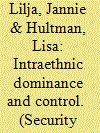

|
|
|
| 5 |
ID:
096859
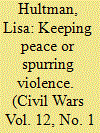

|
|
|
|
|
| Publication |
2010.
|
| Summary/Abstract |
Are peace operations effective in managing violence against civilians in civil wars? I examine the short-term effects of peace operations on the intensity of violence against the civilian population in internal conflicts. Missions are often sent to ongoing conflicts, where the warring parties have not yet managed to settle their dispute through the use of military means. I propose three mechanisms through which the presence of a third party may increase the parties' incentives to target civilians. A quantitative assessment of all intrastate armed conflicts, 1989-2006, shows that while the presence of a peace operation does not have a clear effect on government violence, it is associated with higher levels of violence by rebel groups. Only UN peace operations with an explicit mandate to protect civilians significantly reduce violence against civilians by rebels.
|
|
|
|
|
|
|
|
|
|
|
|
|
|
|
|
| 6 |
ID:
173893


|
|
|
|
|
| Summary/Abstract |
In this article, we introduce the Geocoded Peacekeeping Operations (Geo-PKO) dataset, which presents new data on subnational peacekeeping deployment for all UN missions to Africa, 1994–2014. The Geo-PKO dataset is the most comprehensive dataset of its kind and enables scholars to address new questions about peacekeeping operations and their effects by exploring variations in peacekeeping at the subnational level. The dataset offers information on several key features of peacekeeping deployment at the local level, such as data on the size of deployments and how these vary over time, as well as information on the location of mission headquarters, the type of peacekeepers deployed, and which troop-contributing countries deploy to each location. This article describes the data collection process and illustrates some of the many utilities of this dataset for the scholarly community. For example, we show that peacekeeping troops are able to reduce battle-related violence in areas with high road density, suggesting that peacekeepers’ ability to project their power is stronger when they can increase their reach and more easily patrol larger territories. Hence, our data can fruitfully be combined with information such as socio-economic, geographical or demographic characteristics, to further explore how peacekeeping operations can contribute to peace and security in the areas where they operate. By providing fine-grained data on the location of peacekeepers across time and space, the Geo-PKO dataset should help facilitate important inquires that can push the research agenda on peacekeeping forward.
|
|
|
|
|
|
|
|
|
|
|
|
|
|
|
|
| 7 |
ID:
151272


|
|
|
|
|
| Summary/Abstract |
In recent years, international third parties have increasingly sought to manage the dire consequences of civil war, often by deploying peacekeeping operations. However, peacekeepers sometimes face deliberate attacks by armed groups. These attacks hamper efforts to provide humanitarian relief and security. This raises a critical question: what factors lead rebel groups to target peacekeepers? We argue that internal conflict dynamics are important for explaining this phenomenon. Rebels attack peacekeepers as an alternative strategy to undermine incumbent regimes. They adopt this strategy as the balance of power turns against them in their struggle against governments. We evaluate our argument using a novel event data set on violent attacks on peacekeepers in sub-Saharan Africa from 1989 to 2009. We find a positive relationship between rebel losses and violent attacks on peacekeepers. These findings hold when controlling for mission-specific characteristics, time-invariant unobserved heterogeneity, and across different model specifications.
|
|
|
|
|
|
|
|
|
|
|
|
|
|
|
|
| 8 |
ID:
165160
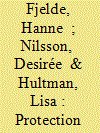

|
|
|
|
|
| Summary/Abstract |
Are UN peacekeepers effective in protecting civilians from violence? Existing studies examine this issue at the country level, thereby making it difficult to isolate the effect of peacekeepers and to assess the actual mechanism at work. We provide the first comprehensive evaluation of UN peacekeeping success in protecting civilians at the subnational level. We argue that peacekeepers through their sizable local presence can increase the political and military costs for warring actors to engage in civilian targeting. Since peacekeepers’ access to civilian populations rests on government consent, peacekeepers will primarily be effective in imposing these costs on rebel groups, but less so for government actors. To test these conjectures we combine new monthly data on the location of peacekeepers with data on the location and timing of civilian killings in Africa. Our findings suggest that local peacekeeping presence enhances the effectiveness of civilian protection against rebel abuse, but that UN peacekeeping struggles to protect civilians from government forces.
|
|
|
|
|
|
|
|
|
|
|
|
|
|
|
|
| 9 |
ID:
153662
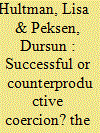

|
|
|
|
|
| Summary/Abstract |
Despite the frequent use of economic and military-specific sanctions against countries affected by civil conflicts, little is known about the possible impact that these coercive tools have on conflict dynamics. This article examines how threats and imposition of international sanctions affect the intensity of civil conflict violence. We formulate and test two competing views on the possible effect of economic and military-specific sanctions on conflict dynamics by combining data on fatalities in battle-related violence in all internal armed conflicts in Africa from 1989 to 2005 with data on economic sanctions and arms embargoes. The results indicate that threats of economic sanction and arms embargo are likely to increase the intensity of conflict violence. Similarly, imposed economic sanctions are likely to contribute to the escalation of conflict violence. Imposed arms embargoes, on the other hand, are likely to reduce conflict violence. We conclude that international sanctions appear to be counterproductive policy tools in mitigating the human cost of civil conflicts unless they are in the form of imposed arms embargoes attempting to limit the military capacity of the warring parties.
|
|
|
|
|
|
|
|
|
|
|
|
|
|
|
|
| 10 |
ID:
121790


|
|
|
|
|
| Publication |
2013.
|
| Summary/Abstract |
Protection of civilians is now at the forefront of the responsibilities of the international community. There is a strong international norm that civilian populations should be protected from violence. But how committed is the United Nations to acting in line with this norm? I argue that the UN Security Council (UNSC) has an interest in demonstrating that it takes violence against civilians seriously. Through a broadened security agenda including human security, the legitimacy and the credibility of the UNSC hinges on its ability to act as a guarantor of civilian protection. As a consequence, the UN is more likely to deploy peace operations in conflicts where the warring parties target the civilian population. The argument is supported by a statistical examination of all internal armed conflicts in 1989-2006. The results show that the likelihood of a UN peace operation is higher in conflicts with high levels of violence against civilians, but this effect is mainly visible after 1999. This year marked a shift in the global security agenda and it was also when the UNSC first issued an explicit mandate to protect civilians. Conflicts with high levels of violence against civilians are also more likely to get operations with robust mandates. This suggests that the UNSC is not just paying lip service to the protection norm, but that it actually acts to implement it.
|
|
|
|
|
|
|
|
|
|
|
|
|
|
|
|
| 11 |
ID:
134936
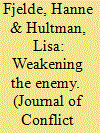

|
|
|
|
|
| Summary/Abstract |
While case-based narratives from civil wars often stress the ethnic dimension of civilian atrocities, cross-national studies have found limited evidence in support of such contentions. Addressing this debate, we argue that warring actors often use ethnic affiliation to identify groups of suspected enemy supporters when individual wartime affiliations are not known. Since warring actors depend on their civilian constituencies for support, collective targeting of the enemy’s co-ethnics becomes a strategy for weakening the enemy’s capacity. Armed actors are thus more likely to engage in civilian abuse in areas where the enemy’s ethnic constituency resides. To examine this argument, we combine new georeferenced event data on violence against civilians in African conflicts, 1989–2009, with spatial data on the location of the warring actors’ ethnic constituencies. The analysis shows that the number of civilians killed by both governments and rebel groups is higher in areas inhabited by the enemy’s ethnic constituency.
|
|
|
|
|
|
|
|
|
|
|
|
|
|
|
|
|
|
|
|
|